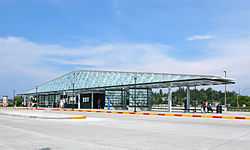Layover
In transportation, a layover, stopover, or connection is a break between parts of a single trip, where the traveler typically gets off one vehicle and gets on to another.
Mass transit


A layover for a mass transit line refers to the break the driver or the vehicle is given at the end of a trip before it starts operating its reverse route, or if the route is circular, before beginning its next trip. The layover has several benefits. These include:[1]
- If the service has arrived at the final point behind its scheduled time, this allows for make-up time prior to starting the next trip, and therefore, better schedule adherence on the route.
- Allows for the operator of the vehicle to have a break without disrupting the service. If a shift change is necessary, this also can be done here without disrupting the service.
- In some cases, may allow for the vehicle being used to undergo a safety inspection.
The typical layover for a public bus line may be:
- A bus stop along the street in a location where the vehicle's presence will not be disruptive to the flow of traffic.
- An apartment complex or other similar development.
- A mall or shopping center parking lot or similar facility.
- A well-known landmark, such as a hospital, college or university, or a government facility.
- A subway station, commuter rail station or a park-and-ride lot.
Sometimes, such a location may serve as a layover for more than one bus line. Many cities have specified locations, known as hubs or bus stations, which serve as a layover point for several routes. In many cases, the layover point for one route may simply be an intermediate stop for another, where riders can transfer.
Air
In air travel, a stop or transfer (from one airplane to another) is considered to be a layover or connection up to a certain maximum allowed connecting time, and a stopover or break of journey otherwise. The maximum time depends on many variables, but for most U.S. and Canadian itineraries, it is 4 hours, and for most international itineraries (including any domestic stops), it is 24 hours. In general, layovers are cheaper than stopovers, because the notion is that layovers are incidental to traveling between two other points, whereas stopovers are among the traveler's destinations.[2][3][4]
Rail and bus
Layover in long-distance travel by train or inter-city bus can refer to a break that a passenger must take between vehicles in a multi-vehicle trip. It refers to the time that is spent at a terminal after departing one vehicle and waiting to board the next. Many inter-city and international travelers face layovers during their journeys.
As in mass transit, the term layover is also applicable in long-distance travel for breaks taken by operators. A vehicle is said to be laying over after it finishes its route and is waiting prior to a return trip, or else it is taking a break to change crews or for the crew to rest.
See also
| Look up layover in Wiktionary, the free dictionary. |
| Look up stopover in Wiktionary, the free dictionary. |
- Bus terminus
- Transportation hub
References
- ↑ Transit Glossary - Sacramento Regional Transit
- ↑ Nicholas Kralev, Decoding Air Travel: A Guide to Saving on Airfare and Flying in Luxury, ISBn 146101543X, p. 23
- ↑ International Air Transport Association, "Passenger Glossary of Terms", Excel spreadsheet
- ↑ Airline Tariff Publishing Company, "Glossary" Connection Stopover
| |||||||||||||||||||||||||||||||||||